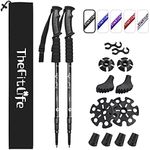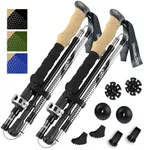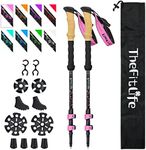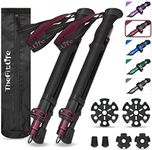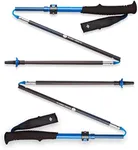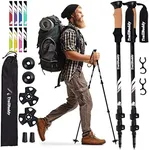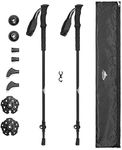Buying Guide for the Best Folding Hiking Pole
Choosing the right folding hiking pole can significantly enhance your hiking experience by providing stability, reducing strain on your joints, and improving balance on uneven terrain. When selecting a folding hiking pole, consider the terrain you'll be hiking on, your physical needs, and the pole's weight and portability. Understanding the key specifications will help you make an informed decision that best suits your hiking style and needs.MaterialThe material of a folding hiking pole affects its weight, durability, and cost. Common materials include aluminum and carbon fiber. Aluminum poles are generally more affordable and durable, making them a good choice for rugged terrain. Carbon fiber poles are lighter, which can be beneficial for long hikes or when every ounce counts, but they may be more prone to damage if not handled carefully. Consider your hiking conditions and how much weight you're willing to carry when choosing the material.
WeightThe weight of a hiking pole is crucial for comfort and ease of use, especially on long hikes. Lighter poles are easier to carry and can reduce fatigue, but they might be less durable. Heavier poles, while more robust, can add to the overall weight you need to manage. If you plan on long-distance hiking or need to minimize weight for travel, opt for lighter poles. For shorter hikes or more challenging terrains, a slightly heavier pole might offer better support.
Foldability and LengthFoldability and length determine how compact the pole can become and how well it fits your height. Folding poles are designed to collapse into a compact size, making them easy to pack and carry. Consider the folded length to ensure it fits in your backpack or luggage. The extended length should match your height and hiking style; adjustable poles offer flexibility to adapt to different terrains and personal preferences. If you frequently travel or hike in varied conditions, a pole with good foldability and adjustable length is ideal.
Grip MaterialThe grip material affects comfort and moisture management. Common materials include cork, foam, and rubber. Cork grips conform to your hand over time and are excellent at wicking moisture, making them comfortable for long hikes. Foam grips are soft and absorbent, providing comfort in wet conditions. Rubber grips are durable and provide a firm hold, suitable for cold weather. Choose a grip material based on the climate you'll be hiking in and your comfort preferences.
Locking MechanismThe locking mechanism secures the pole at your desired length. There are several types, including lever locks, twist locks, and push-button locks. Lever locks are easy to adjust and reliable, even with gloves on. Twist locks are lighter but may require more effort to secure. Push-button locks are simple and quick to use. Consider how often you'll need to adjust the pole length and in what conditions to choose the most convenient locking mechanism for you.
Shock AbsorptionShock absorption features can reduce impact on your joints, especially on downhill sections. Some poles come with built-in shock absorbers, which can be beneficial for those with joint issues or on long hikes. However, they may add weight and cost. If you have knee or joint concerns, or if you plan to hike on rocky or steep terrain, consider poles with shock absorption. Otherwise, standard poles without this feature may suffice for less demanding hikes.

